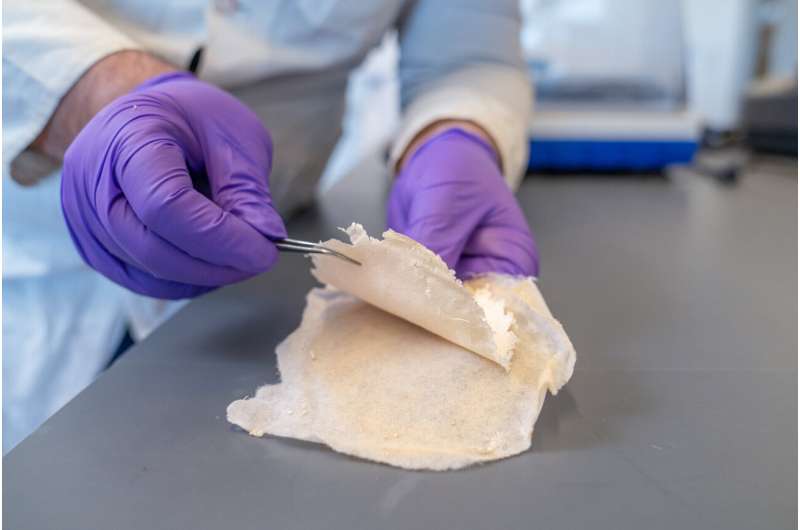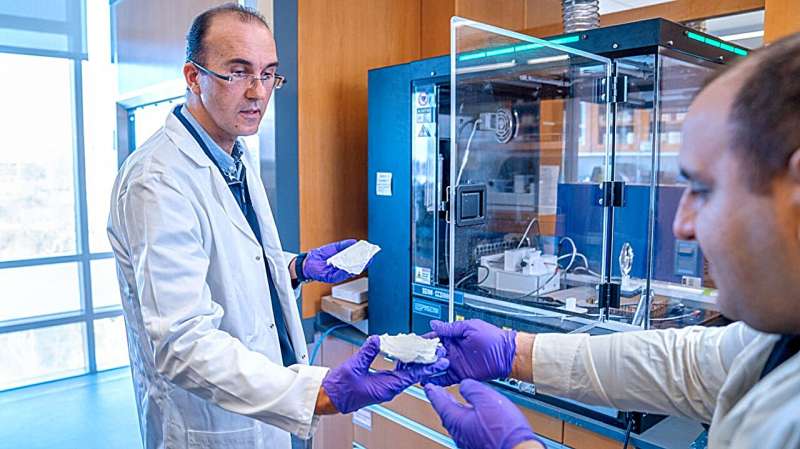This article has been reviewed according to Science X's editorial process and policies. Editors have highlighted the following attributes while ensuring the content's credibility:
fact-checked
trusted source
proofread
Nanofiber-coated cotton bandages fight infection and speed healing

An interdisciplinary team of Cornell researchers has identified an innovative way to harness the antioxidant and antibacterial properties of the botanical compound lawsone to make nanofiber-coated cotton bandages that fight infection and help wounds heal more quickly.
Their findings, published in the International Journal of Pharmaceutics, are especially important given the increasing prevalence of multidrug-resistant bacteria.
Cotton gauze is one of the most common wound dressings; it's inexpensive, readily available, comfortable and biocompatible. However, it doesn't promote healing or fight infection.
"Cotton alone cannot provide an answer for these complications—it needs to be biofunctionalized," said lead author Mohsen Alishahi, a doctoral student in fiber science who works in the NanoFibers and NanoTextiles (NanoFibTex) Laboratory in the College of Human Ecology's Department of Human Centered Design (HCD).
Tamer Uyar, associate professor in HCD and the lab's director, said one of its main research interests is developing functional fibers from sustainable materials and exploring their potential applications in medical textiles and drug delivery systems.
For this work, Alishahi, Uyar and doctoral student Mahmoud Aboelkheir used lawsone, a red-orange compound found in henna leaves that has antioxidant, anti-inflammatory and antimicrobial properties, to boost the performance of cotton.

Lawsone has been shown to help wounds heal more quickly, but it's difficult to dissolve in a solution and not readily absorbed by the body. To overcome these limitations, the team used cyclodextrins, a family of natural oligosaccharides produced from starch, to create an inclusion compound, binding the lawsone molecules within the cyclodextrin.
They then used electrospinning equipment to produce a uniform nanofibrous coating from the lawsone-cyclodextrin solution, capturing it on a nonwoven cotton pad. They found that the experimental dressing had significantly higher antioxidant activity—promising faster wound healing—compared with pure lawsone, thanks to the increased solubility of the lawsone by cyclodextrin inclusion, and the high surface-to-volume ratio of the nanofibrous system.
The NanoFibTex team then worked with Craig Altier, professor of population medicine and diagnostic sciences, and Rimi Chowdhury, senior research associate, both in the College of Veterinary Medicine, to test the dressing's biological properties. The experimental dressing had excellent antibacterial performance against gram-negative and gram-positive bacterial species, and effectively eradicated E. coli and staph bacteria in testing.
"The prolonged overuse of synthetic antibiotics in high concentrations has contributed to the rise of the deadly epidemic of multidrug-resistant microbes," Uyar said. "So the use of natural and potent anti-bacterials such as lawsone may serve as an alternative to synthetic anti-bacterials."
"Wound dressings should provide a suitable environment for facilitating healing and preventing infection," Alishahi said. "Using totally natural materials such as cotton, cyclodextrin and lawsone, this dressing can facilitate both as it has comprehensive antioxidant and anti-bacterial activity."
Alishahi said that the dressing would be particularly helpful for chronic wounds that are highly susceptible to infection, like diabetic ulcers and burns. The antioxidant and anti-inflammatory properties would also benefit more routine wounds by reducing the formation of scars.
"I am familiar with the complications patients face due to the lack of suitable dressings," said Alishahi, who formerly worked in a burn- and wound-healing research center. "My ultimate goal is to develop a dressing that can overcome these difficulties for them. This work opens doors to creating medical textiles that are good for the environment and great for healing."
More information: Mohsen Alishahi et al, Functionalization of cotton nonwoven with cyclodextrin/lawsone inclusion complex nanofibrous coating for antibacterial wound dressing, International Journal of Pharmaceutics (2024). DOI: 10.1016/j.ijpharm.2024.123815
Provided by Cornell University





















